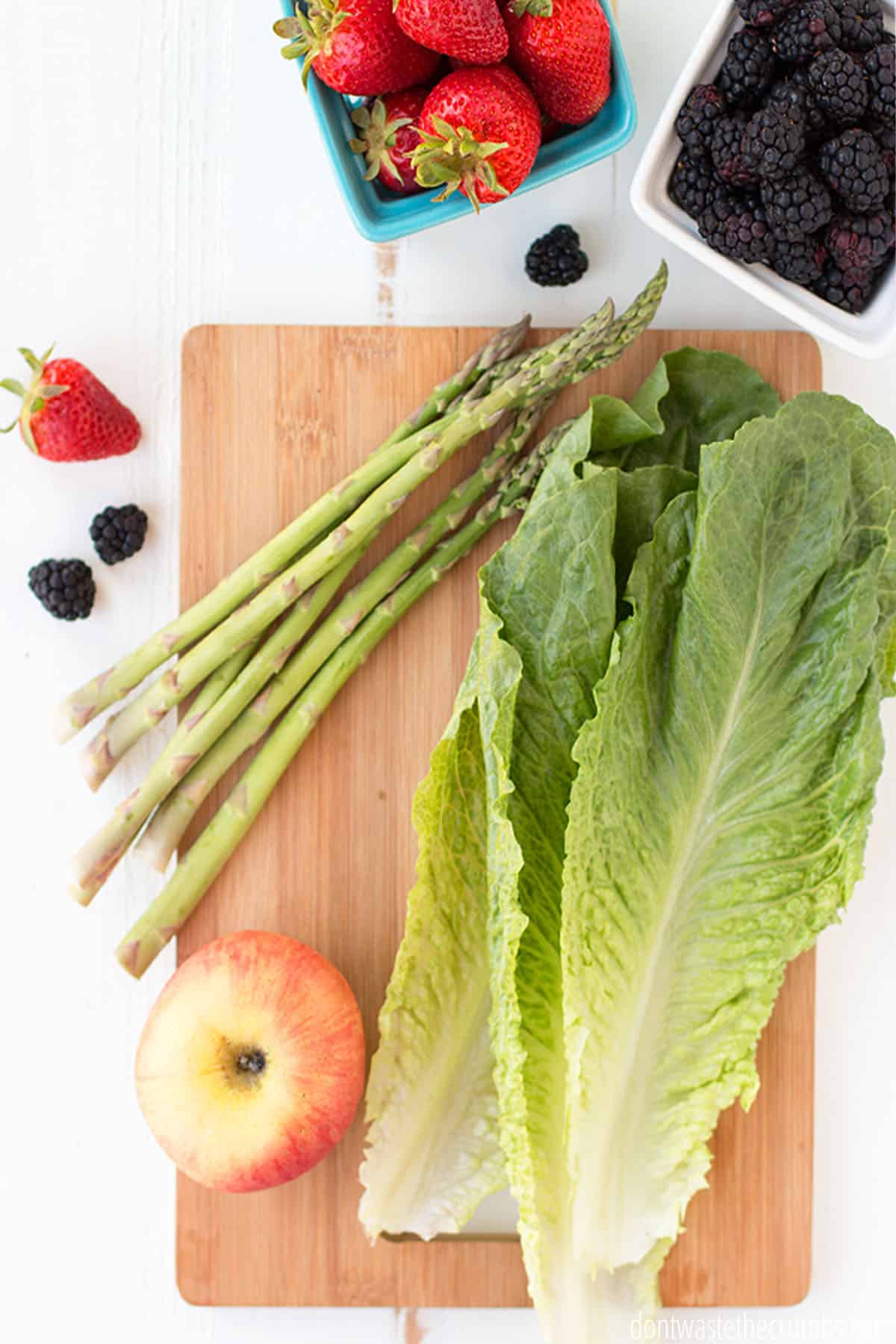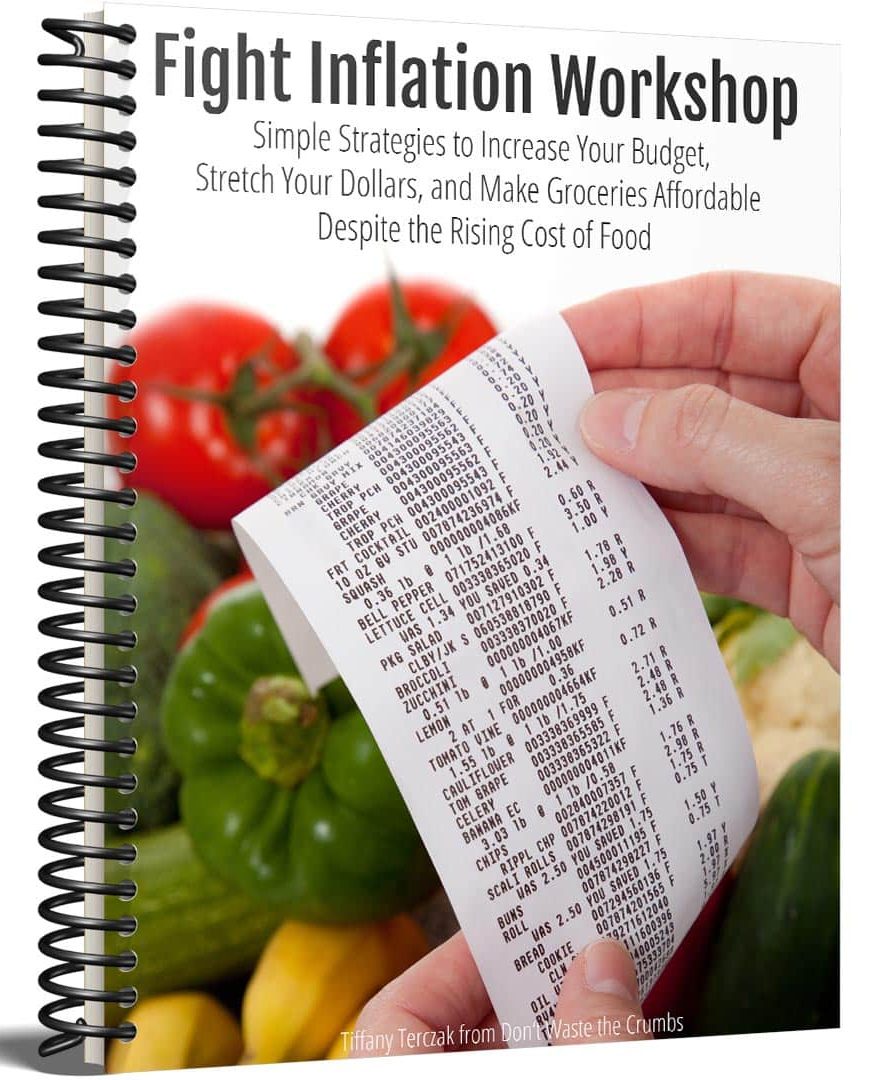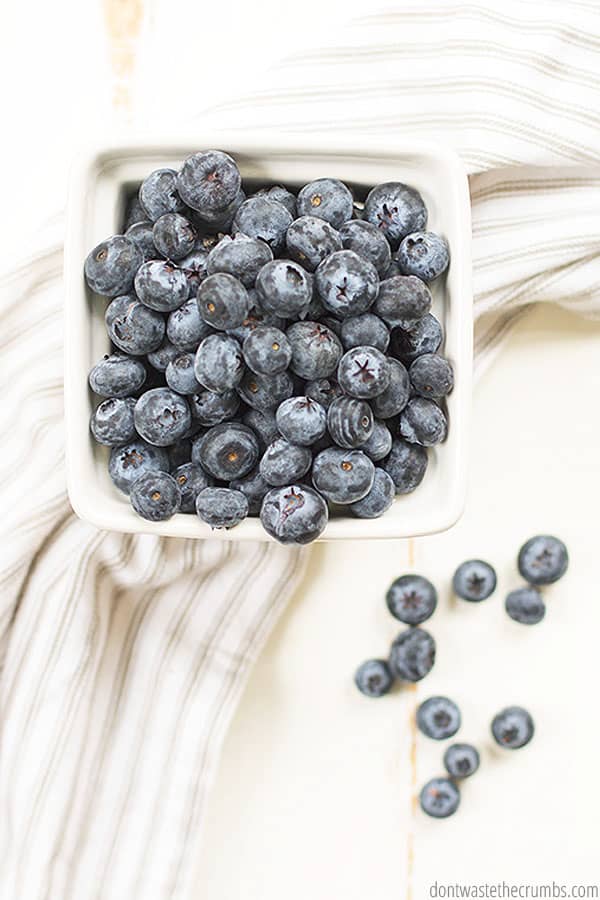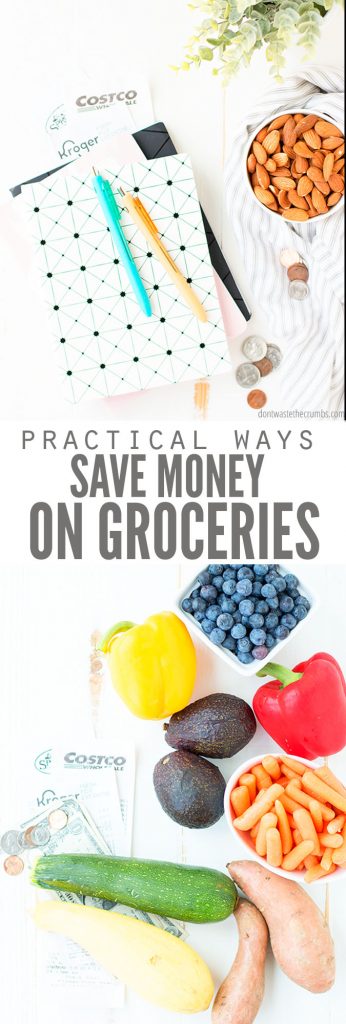Want to know how to save money on groceries? These practical tips work for any family and any budget – use them every week to save on food!
Sometimes saving on food is just plain ol’ hard.
One week you’ll have a plan to use up what’s in the kitchen and supplement with the great deals at the grocery store.
Then the next week nothing is on sale AND you’ve got a bare kitchen (because you ate it all last week). All the supermarket money you saved that first week? Gone.
Have you ever felt this way before?
You’re not alone there!
SAVE MONEY AT THE SUPERMARKET
Spending less on your grocery bill literally happens one shopping trip at a time. It’s 50 cents here, and a few bucks there. It’s choosing to eat stir-fry with millet because it’s in the pantry, and not making a trip to the store for rice. When you stick to the grocery shopping list and shop for competitive prices, it is truly possible to feed your family on a budget.
A successful grocery budget is achieved over many months, if not years, with each menu plan you write and each item you put (or don’t put) in your cart.
So, let’s get to work. I have a few tricks up my sleeve that keep the grocery budget in check month after month. If they can help me, I know they can help you!

HOW TO SAVE MONEY ON GROCERIES RIGHT NOW
How can I spend less money on groceries? This is a big question, and while there are almost infinite strategies to save on food, these practical ways to save money on groceries are a good starting point to see quick savings.
1. STOP BUYING SALAD DRESSINGS.
Salads are a GREAT way to eat more fresh fruits and vegetables. They’re also a perfect opportunity to use meat as a condiment rather than the main focus of the meal.
Most store-bought salad dressings are filled with something to make it taste good (sugar), something to make it creamy (lecithin), and something to make it taste “fresh” even though it’s been sitting on a shelf for well over a year (preservatives).
Homemade salad dressings are easy to make and contain only the ingredients YOU want them to have.
Stop spending $3-5 PER BOTTLE and start making your own instead.
Enjoy these homemade dressing recipes!
Ranch:
Caesar:
Classic Italian and Greek:
Perfect for Asian Flavors:
Amazing for Mexican Flavors:
Tip: Turn any vinaigrette dressing into a “creamy” dressing by substituting plain yogurt for the olive oil.

2. STOP BUYING SNACKS.
Seriously, just stop. I know it’s easy to have them on hand, but you’re really buying expensive items for the packaging. And if you’re looking for snacks that are allergy-friendly? There goes your budget!
Most boxed snacks, brand name or store brand, have SOMETHING in them to keep them shelf-stable, or they’re processed in a way that prevents them from going bad.
Yikes, which is worse?!
If you really want to know how to save money on groceries, choose fresh fruits, veggies, and proteins instead! Create a snack box in the fridge and/or the pantry so it’s just as convenient as the pre-packaged goods. Here’s how:
1. Line a large, flat container with either a napkin or a paper towel. Add as much of the following as you have or can fit. You may want to pre-portion these for easy grab-and-go snacks, or just have containers of the snack items for your family members to choose from.
For the fridge:
- Carrot slices
- Celery slices
- Zucchini slices
- Cheese slices
- Cherry tomatoes
- Homemade gummies
- Homemade fruit leather
- 2-3 spoons (for scooping and eating yogurt)
For the pantry:
- Homemade granola clusters or granola bars
- Mandarin oranges
- Bags of trail mix
- Small apples
- Bananas
- Honey roasted almonds
2. When the family is hungry, pull out the box and leave it on the counter for them to pick/choose their snack(s). Put it away when they’ve chosen and have them wait until mealtime to eat again.
If you’re willing to scoop some yogurt for those who choose it, this can be a mostly hands-off approach and MUCH more filling than the packaged snacks. Plus, kids like being able to pick what THEY want for a snack. You just choose the options beforehand.
3. STOP THROWING FOOD AWAY.
Don’t throw your kitchen scraps into the trash can! Make Vegetable Soup or Homemade Stock instead. Here’s what I’ve used from my fridge to make minestrone soup:
- Celery
- Cabbage
- Carrot
- Zucchini
- Squash
- Onion
But I could have also saved:
- Tomato tops
- Wilted lettuce
- Wilted spinach
- Broccoli stems
- Beet greens
- Asparagus ends
By no means is this an exhaustive list, but it helps to show how much food we throw away that is still perfectly edible!
Here’s my Minestrone Soup recipe for using up stray kitchen stuff. You can also make Chicken Stock with kitchen scraps or use this list of ways to avoid food waste!
4. DON’T WORRY ABOUT BUYING EVERYTHING ORGANIC…
At least not right now. If you’re really trying to save money to pay rent or utilities or other bills, the cost of organic food might be out of your budget (plus organic isn’t always what it’s cracked up to be).
There are plenty of ways to mitigate this though, especially if organic food is a priority to your family.
- First, only buy organic what you eat a lot of, and what you whole-heartedly believe is worth it.
- A food that you eat once a week doesn’t need to be organic. But the chickens or produce you’re eating at every meal? That should rank a bit higher on the list.
- Learn how to find affordable organic food in your area and shop the Dirty Dozen and Clean Fifteen.
- Find ways to enjoy the farmers market without going broke and learn what the stickers on produce mean at the grocery store.
There is a time and a place to buy organics (grass-fed, local, raw, non-GMO, etc.), but prioritizing your budget and needs comes first. (This is the very first lesson I teach in Grocery Budget Bootcamp. Enrollment is currently closed, but you can join my FREE 5-day Crush Inflation Challenge and start saving money on groceries tomorrow!)

5. LEARN TO LIKE BEANS TO SAVE ON FOOD.
There. I said it.
With every penny at stake, there’s no room for “I don’t like beans.”
I know dried beans aren’t the most glamorous food, but your body need fuel, beans are a nutrition powerhouse. Plus, they’re cheap.
Find a couple of varieties that you can tolerate and eat them often. Garbanzo beans, white beans, and brown lentils are the friendliest types of beans for beginners. They’re even more affordable when buying large quantities in bulk.
Make bean burritos, eat beans over rice, add them to burgers, make hummus, bake brownies – do what you have to do to eat them at least three times each week (including all meals, not just dinner), especially if you’re cutting back on other protein sources.

6. FOCUS ON YOUR TASK OF SAVING MONEY ON GROCERIES.
It is SO easy to get distracted by the pretty packaging and the different varieties of foods at the store. I found myself oohing and ahhing over cheese just last week! But knowing how to save money on groceries for the long run is important.
- Always shop with a grocery items list and stay focused. In fact, shop as if you’re already late for an appointment.
- Shop without kids if at all possible, and definitely don’t shop when you’re hungry.
- Treat grocery shopping as an errand. You’re on a mission to get in, shop the list based on your meal plan, and leave. Viewing this errand as an excursion or something fun is a sure-fire way to ruin the budget with impulse purchases.
- You’re on a mission to get in, shop the list based on your meal plan, and leave. Viewing this errand as an excursion or something fun to do is a sure-fire way to ruin the budget.
- Don’t get distracted by things that are not on your grocery list and don’t even bother going down the aisles you don’t have to!
7. USE A PRICE BOOK.
Comparing prices can be overwhelming, but by creating a simple price book, you can really start seeing the savings roll in.
You don’t even have to go to all the stores every week to check prices! You can use the Flipp app to check local grocery store discounts, coupons, and ads. Then record the prices in your price book.
If you use grocery delivery services or store pick-up, be sure to factor in any fees to your price comparison. Warehouse stores like Costco and Sam’s Club will have an annual fee as well, so keep that in mind.
Here are some price comparisons I’ve done:
By choosing even one item on this list, you’ll start to see savings on food. How will you start to save money at the supermarket this week?
If you need a bit more help saving on groceries, sign up here for the FREE Fight Inflation Workshop. I can’t wait to share three AMAZING sessions focused on saving money on groceries NOW – despite the rising cost of food!
MORE TIPS ON HOW TO SAVE MONEY ON GROCERIES
- How to Save Money with a Pantry Challenge
- 38 Ways to Save Money on Food Year-Round
- 10 Ways to Save Money on Coffee
- How to Save Time and Money with Batch Cooking
- How to Save Money on Real Food Using Ibotta











Hey Tiffany;
Just read my first “Don’t waste the crumbs ” email I signed up for. I need to confess, I had just glanced at your site and decided why not get this info sent to my inbox.
Wow! I am so completely impressed with every tip offered, every recipe gets checked over, and atleast two of these have made the cut.
I have been running my own home, and all the needs of a family of five, and more often meals that included many weekly
drop-ins for years and years. For the most part, this was done on a shoe string budget, as we were involved in missions (not noted for its great salaries, nor does it attract those looking to make big buck). I learnt a lot about ” throwing that extra bean into the pot” during these times. Our budget forced us into learning to live with little, yet always having food to share. Gardening was a must. Local farmers gave us great deals on beef, pork and poultry. Learning to can, another must, as well as leaning to use a freezer properly. Going straight to the source, if possible always saves money.m
Now, we are thankful to have learnt to live with little, and learnt to live with much. Our life style has changed a great deal since our children have their own families. Once again we must reajust our spending, as my husband has just retired, and we will be living on a fixed income( much less, might I add ). After reading your web site I was invigorated and challenged by our newest set of circumstances. You have kick-started my need to be far more created with looking after the home-front. I want to do this with as much pizzaz and joyful experimentation as I can. I do have many years of experience to draw upon, but times have changed and there is a plethora of new ways to do up financial limitations with a flare! So, rather than beginning this with a groan, I’m excited by your creative suggestions. Some are new for me, others are just fantastic reminders to get back to our roots once again.
Tiffany, thanks for the inspiration and I would be remiss if I didn’t tell you, how much I look forward to all your wonderful up-coming email.
Truly grateful for you and your latest findings.
Thoughtly delighted;
Colleen
I really am pumped about your web site and plan to spread the word to all the people I will come across, whether seniors, or recently unemployed, or those who love to do thing up with a bang, and not so much the buck!!!
Wow Colleen! I’m incredibly humbled by this comment, yet excited at the same time! I’m SO glad you’ve found encouragement, reminders and new ideas here as you venture into a new season in life. Thank you for taking the time to share this with me – I look forward to “seeing” more of you here!! <3
One thing that has really helped me save money on groceries is to take advantage of what is offered at work. Even though I’ve worked in a variety of jobs, most have offered some sort of food perk. While working at a conference center, I got take home lots of the food that was going bad in the kitchen. (I used brown bananas for banana bread and froze spinach for green smoothies.) A food gift corporation I used to work for over a year ago has so much overstock that I still get to occasionally come in and take a bag of groceries. And of course if a free meal is served at work, I’m game for that too! (Yes, sometimes free work food requires sacrificing some health aspects, but other times it provides me with a quality of food I could never afford on my own!)
Yes Jessica! I did this too when I was in a typical work environment, and I still encourage my husband to take advantage if the food isn’t too poor in quality. Thank you for sharing!
Thank you for these ideas. I do still try and budget for snacks but now I will make my snacks fruits and veggies and other whole foods! I do try several times to have beans as the centerpiece for dinner with the attitude of “learn to like beans”. However, even after a year or so my kids still spit the beans out or just plain refuse to eat them. It’s very frustrating and a bit defeating. I can get them to eat it if I do “refired” bean burritos. Any suggestions are welcome and appreciated
*refried beans
Beans are tough Desiree, and we struggle with it too. One way is to find out what they like by talking to them, and just serving that once a week or every two weeks. If they like bean burritos, would they like chipotle-style rice bowls with beans?
I have learned myself that “deal with it” doesn’t work for us. They rebel! But if I’m more gracious, they respond better. Also consider the MANY different types of beans out there – they’re all good! I’m actually working on a recipe now that has red lentils – I should have it ready by Monday (and it’ll be an easy way to sneak beans in!)
DH recreated our meat sauce by adding lentils to it. We love it even more with the lentils than without.
Wow! That’s a great idea Debbie! I have a few different lentils too… which kind did he use?
Thanks Tiffany, these are great!
“Nowadays it’s an event. People are buying snacks as they shop, leisurely perusing the isles…”
This is so me, Ha! No more … I’ve known for a while that temptation starts with the eyes. I am going to work on getting “in and out”.
My tactics are; shopping once a week or less, making homemade salad dressings, mayo, Spaghetti sauce and BBQ sauce, gf flour blend, spice blends, etc. Definitely not buying packaged snacks; I believe it makes mealtimes much more enjoyable anyways. Buying in bulk if the price is better and then prorating the costs over the next several months (using a savings account).
I do everything as naturally as possible but am so guilty of buying salad dressings when I know how easy they are to make. Well that stops now! Thank you for the ideas and recipes.
Grocery shop once a week instead of running to the store every few days. There is always something to catch your eye and tempt you to buy even if you are only there for one specific item. Planning your menu out for a week, even just for the main meal each day, makes it much easier to know exactly what you need so you can have it available. If you don’t like to feel tied down to a specific meal on a specific day, make a list of meals to cover the week, and choose which one to fix each day (don’t forget to plan for using the leftovers).
I really like these ideas however, I end up spending more money some weeks because the store will have ‘unadvertised’ deals. They are usually extremely good and may only be on for that day.
For example mustard that we buy and is 3 dollars a bottle will go on for 1 dollar… I end up buying 10 of them, if two or three products are on sale like that it can eat up a good 50 dollars. A good brand of frozen pizza’s were on sale for 1.25 each regular 4.50. We don’t each processed foods very often but this price was so cheap, a person could not make a pizza for that price.
It saves in the long run but it eats into that week or month’s budget.